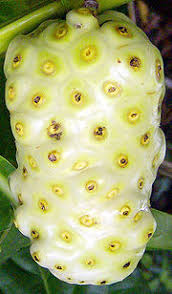NONI NONO MORINDA
MORINDA CITRIFOLIA
RUBIACEAE
With few exceptions, for example in Europe the quail breast and madder, the Rubiaceae are tropical plants, principally trees and shrubs.
This is a great plant family, more than 5,000 species, where there are coffee and two major types of medicine:
cinchona (quinine) and
Cephaelis (ipecac which is extracted emetine).
Many of Rubiaceae are shrubs or ornamental trees include the gardenia (jasmine) and red Ixora flowers.
The Morinda citrifolia is widespread in the tropics, it was first described in India (hence the name) but has always been important in traditional medicine in the South Pacific and particularly in Polynesia and Hawaii.
It is a small tree 3 to 6 m thankful to its fruit, green and hard, becomes soft and yellow in a few hours to mature. The surface of this fruit, noni, is irregular, formed of polygons joined together with a central small plate, perhaps the scar of the flower, it is pyriform, more or less rounded, its size varies from 5 to 15 cm.
Ripe noni off a strong odor, butyric, reminiscent of a cheese or very spoiled fermented hence the common name, cheese, that gave the Europeans.
COMPOSITION AND CHEMICAL PROPERTIES
The juice of ripe noni fruit is hard to get pressure because of the presence of large amounts of mucilaginous material, but after freezing and bursting of cell Stuctures then grinding it easy to collect a liquid acid (pH 3 to 4) which is very fermentable. .
The chemical and pharmacological data are fragmentary and not always checked.
A team of Researchers in Hawaii (A. Hirazumi) revealed an important immunostimulatory effect of extracts from Morinda mice.
There was a significant increase in the number of days of survival in mice bearing a transplanted carcinoma, it seems that this "forgiveness" is due to increased activity of macrophages and / or lymphocytes.
Another researcher Hawaiian (Heinicke) explore a different route and think it exists in a precursor of noni xeronin, a compound that act on proteins' cellular repair. This xeronin be released from the gut. To this investigator, the Noni plant is a "antisénescence" and have various pharmacological properties due to the lack of specificity of action on an organ or tissue.
USES
The Maohi probably intentionally introduced this plant native to Asia and South-East Asia, the islands that they colonized by browsing their large double canoes to Hawaii.
The natural dispersion of noni seems unlikely, in fact, the seeds float but the distances between islands are huge and there is no frugivorous migrating birds in this region.
For the ancient Polynesian Noni, edible only in times of famine, would be anything more than a medicinal plant itself. What was its symbolic or religious, we do not know. A few details were suvécues, for example the fact that at the end of the tattoo, the new initiates must file a noni on the "marae, the sacrificial altar.
More prosaically, noni Green is an astringent, and the root of noni contains anthraquinone pigments that yellow dye plant fiber.
The Polynesians used until recently as the noni plant drug, alone or mixed with others:
Used externally as an antiseptic / antibiotic and anti-inflammatory
* Ripe fruit and leaves are applied directly to the abscess or whitlow to activate the maturation as well as on new tattoos when there is severe inflammation and early infection,
* The juice of the fruit is almost ripe to ease the pain of bites "nohu" (scorpion to sting formidable)
* Fresh leaves are used as poultice on burns,
* Other revenue also existed to treat sore throats (gargle or application of the astringent juice of the noni green) and epididymo-orchitis or abscesses and inflammation of the mammary gland (patch of green fruit and ripe).
In internal use:
* We noted a treatment for "Ciguatera" (poisoning the flesh of coral reef fish): noni juice 3 green and 3 ripe noni mixed with coconut water,
* Treatment of "abdominal tumors (unspecified): noni juice combined with green peppers and the juice of the fruit of" miro (Thespesia populnea).
In modern Polynesia, the noni fruit is still a medicinal, it collects the juices flowing spontaneously ripe noni as:
* Anti-arthalgique, anti-senescence: 1 tablespoon per day every day or per course of 8 days (because of the risk of stomach ache)
* Anti-infective skin (acne, boils): 1 to 2 tablespoons per day during several days
* Applying directly the ripe fruit of noni on tender joints (gout)
For several years, Americans (USA) interested in this herb.
During World War II, American GIs based in BORA BORA (French Polynesia) had the opportunity to use, recommended by the Polynesians, and the plant was therefore authorized to import USA.
Currently, the pulp of the noni fruit (particularly those of the Marquesas Islands), we extract a liquid that is added to fruit juices more common (orange, passion fruit) to make a drink noni (Morinda or).
Although U.S. health officials do not yet recognize the extract of noni as herbal medicines, drinking is still marketed as a natural tonic, anti-aging, immune stimulator, with the argument implied the possible protection against the cancerous degeneration.
It would be highly desirable for this plant and its fruit are revalued pharmacologically, because if they can immunostimulant was confirmed, the Morinda Citrifolia, plant sturdy and easy to grow, provide a herbal paramount.
0 commentaires